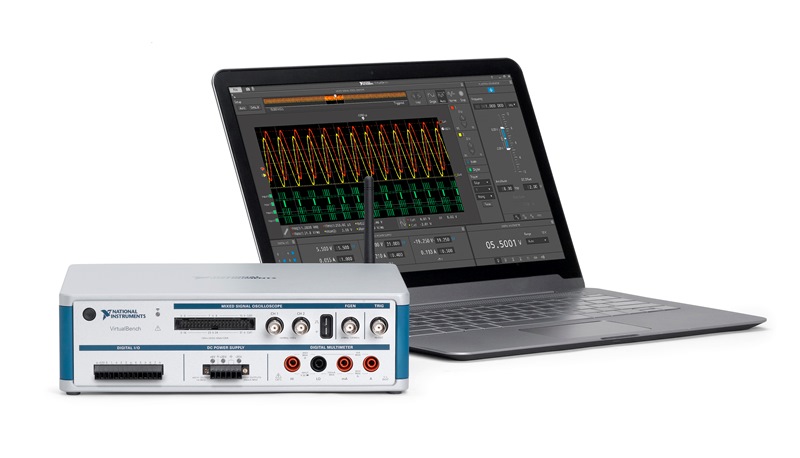We recently had the opportunity to interview Graham Green, National Instrument’s Senior Product Manager – Data Acquisition, about NI's development of the VirtualBench, a 2014 Product of the Year. Here’s what he had to tell us.

Richard Comerford : How did the idea for VirtualBench come about? Who were the people involved at the very beginning?
Graham Green : Several individual R&D and product teams had been researching several ideas of how to provide instrumentation for the modern engineer, but we ultimately saw the need for a truly multifunction instrument. Multifunction capabilities in data acquisition devices are now a commonplace expectation in most automated measurement systems, while interactive test has been restricted to single function instruments for many years. NI's vision was to bring this multifunction capability to the instrumentation world. We brought together experts from our oscilloscope teams who had expertise in highly accurate analog design and from our data acquisition group who had experience on working with small form factors and low cost designs. Together they collaboratively built a wholly new class of instrument and set about changing the expectations of interactive test users.
Richard : What was the critical factor in committing to VirtualBench’s development?
Graham : The fun part of any new design idea is the validation with the target market. In fact, we sat down with experienced engineers in regions across the world and used a cardboard model with features and I/O simply drawn on the front, accompanied by an iPad with a mockup UI. The reaction we received was overwhelmingly positive; people understood the fact that it would be significantly more practical to have a single, small, portable device than a bench full of instruments.
Richard : What hardware and software technologies had to be developed?
Graham : To do this there were four main technological challenges to overcome:
1. Analog design – To meet the goal of an aggressively low price for the end user, we had to engineer analog circuitry for each instrument that could be manufactured economically without sacrificing measurement accuracy.
2. Small form factor – Since we wanted the final product to fit easily into your average backpack, we spent considerable effort compressing our design far beyond conventional instrumentation standards. This lead to further challenges for noise and cooling, but we had to work through making the size of the final product something compelling and convenient for the end user.
3. Driver architecture – We also wanted to minimize the time spent installing software, so we decided early on that VirtualBench had to have a “plug and play” software experience for extreme ease of use. To achieve this we had to re-achitect our driver platform to allow most of the intelligence to be hosted internally on the VirtualBench itself. This turned out to be a lot of work, but resulted in a quick and painless install that can be ported automatically over the USB.
4. User Interface – Over the past few years we saw traditional box instruments’ user interfaces getting more and more complicated. With more knobs, dials, buttons, touchscreens and settings, these instruments can be hard to navigate. The challenge was to do this without losing functionality and scale it to multiple platforms such as a PC or an iPad.
Richard : Who worked on the product development?
Graham : Building a product such as this takes a really multidisciplinary team. Hardware engineers, software engineers, mechanical engineers, industrial designers, UX specialists, and employees intimately familiar with the needs and care-abouts of our target audience collaborated in the development of VirtualBench.
Richard : What happened in getting the VirtualBench from design to manufacturing? Were there changes in the design along the way? If so, why?
Graham : One of the huge benefits of making VirtualBench software-based is that development can continue after product release. In the same way that adding functionality to your smartphone is characterized through software updates, we still have a sizable team working on VirtualBench and we have committed to adding functionality through the release of free software updates. For example, one of the requests we had on release was to enable SPI and I2C decoding; this we achieved with just a driver and firmware update that we released online free earlier this year. With continued user feedback, we can make a better and better product with zero expense to our existing user base.
Richard : What has the market acceptance been like? What feedback did you get from the marketplace?
Graham : The feedback from the market has been overwhelmingly positive. Most of our time is spent with R&D engineers at design companies, but with VirtualBench we have the opportunity to work with a new audience – field sales engineers, technicians, the academic industry, and SMEs and SMBs. For example, Ronald Williams is Professor of Electrical Engineering at the University of Virginia. He stated “The functionality, intuitive interface, and ease of use built into VirtualBench allowed more time for students to focus on concepts and increased the time on task in the lab.”
Richard : Has the VirtualBench’s development led to ideas for future products? How do you foresee the VirtualBench growing in the future?
Graham : Virtual instrumentation has become a standard for automated test, but the market has quickly adopted the virtual stance for interactive use too. We will continue to invest in this as we see this as a major shift in the future of engineering use. In the future, we hope to offer more functionality both in the hardware and the software and will introduce VirtualBench to wider audiences and markets. In a few years, we predict that a large percentage of interactive measurements will be taken with a virtual instrument approach. Reducing the cost and desktop real-estate for the user while maintaining instrument accuracy and use is what we envision for the future.
Advertisement
Learn more about National Instruments





